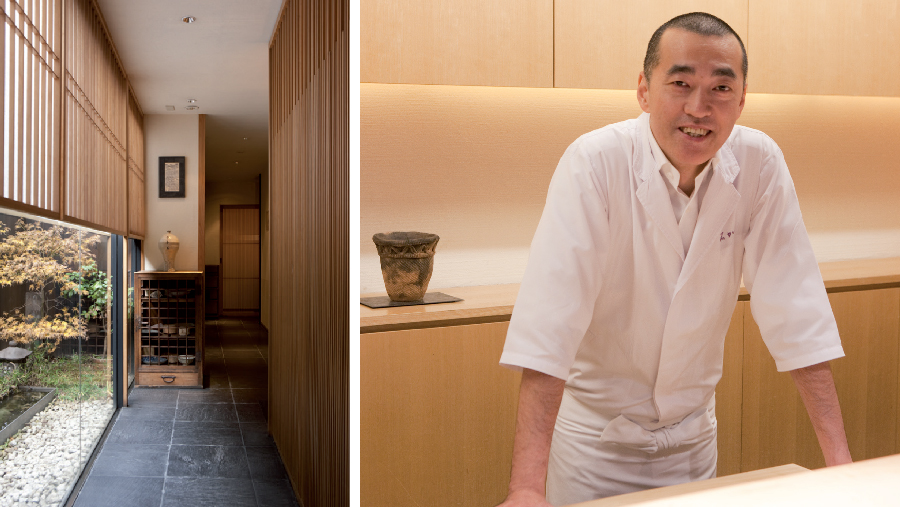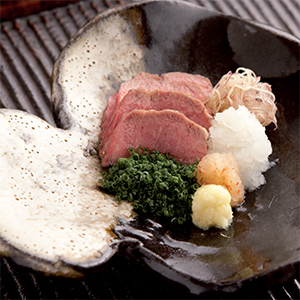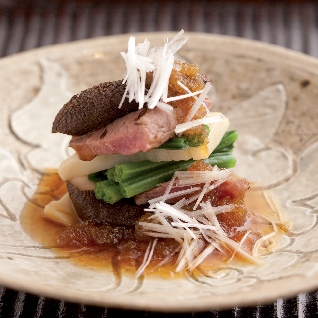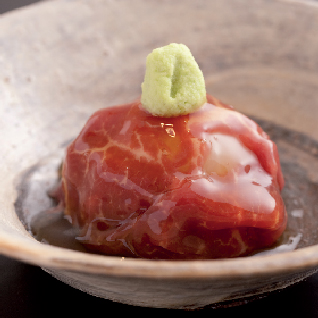Kagurazaka is a great area for going out, just outside the centre of Tokyo. It has always had a lot of bars and restaurants and at the beginning of the 20th century, became well known for its numerous geishas and traditional restaurants. Unfortunately, most of these have disappeared. Today, you will find a remarkable number of French restaurants here, influenced by the French school and French Cultural Institute nearby. Here in Kagurazaka, just behind the Bishamonten Temple, you will find Chef Hideki Ishikawa’s three-star restaurant. The smart exterior is built out of black wood, and has an entrance that is almost invisible. Even the name of the restaurant is very discreet (and only in Japanese). The restaurant exudes minimalism and sobriety, with just a few artefacts to give the interior its sense of elegance. The restaurant has 4 private rooms and a counter made from 400-year-old cypress tree, which seats 7 people. Ishiwaka is an avid collector of bone china and stonework, which has turned out to be a hobby that suits him perfectly when he is choosing the dinnerware on which to serve his food. Presentation is extremely important in Japanese cuisine, in which lots of small dishes and plates are used, made out of different materials and in many different shapes, colours and sizes.
This attention to detail enhances the visual appearance of every dish. At the age of 37, Ishikawa opened his own restaurant, now ten years ago, and the reservations are fully booked weeks in advance: reservations form all over the world. Ishiwaka has a crew of ten.
Reviews of his cooking often describe it as kaiseki (Japanese haute cuisine), but he says that whilst there are some similarities, he likes to come up with his own interpretations of Japanese cuisine. Whichever of these opinions you might prefer, one thing is certain: the chef upholds the tradition of changing with the seasons: his menu consists of numerous small dishes which are changed about seven to eight times a year. Every meal always starts with some Takikomi Gohan, a very appetising rice dish which alternates ingredients throughout the year. This one of the elements that has made Ishiwaka so famous. Ishikawa also uses meat, like duck, wagyu beef and wild boar. We asked Ishikawa if he would like to experiment with veal and make three dishes for us and for the book. This was the very first time he had worked with veal, with a request from us to make it as Japanese as he could. So he did. His first impression? “The veal is tender and it has a great colour. This is something I want to accentuate in my first recipe.”
Generously sprinkle salt on the veal and cook slowly over the charcoal: be sure to keep it pink on the inside. Cut the meat into slices and prepare a garnish of grated daikon, grated ginger and grated daikon with chilli peppers, finely-chopped chives and grated Japanese ginger. The Ponzu sauce consists of a blend of dark soy sauce, mirin, sake (from which the alcohol has been evaporated) kombu dashi, bonito and citrus juice. The slices of veal with the finely-chopped garnishes are dipped in the Ponzu sauce at the table.
Cut the veal (sirloin) into slices that are 5 mm thick and grill lightly. Garnish with fried shiitake mushrooms, boiled fresh bamboo shoots, spinach and daikon. Serve this with a tasty mixture of apple, garlic, fried onions, sake (alcohol evaporated), mirin and a dark soy sauce. At the end of our meal, the chef came to the table with something extra and put a dish of veal sashimi down in front of us, with the instructions to eat the meat raw, with some soy sauce and wasabi; nothing else. According to the chef, veal needs very little help to optimise its full flavour.
Wrap a warm kohlrabi in ultra-thin slices of raw veal and pour the warm Ankake sauce over it at the table. This will change the colour of the veal, and will add a visual element of surprise to the dish. Once the sauce has been poured, the dish is ready to be eaten. It is bound to wow the senses. Preparation: peel the kohlrabi and cook in a dashi (bouillon) of light soy sauce and mirin. Then wrap the ultra-thin slices of veal around the kohlrabi. Make an Ankake sauce with dark soy sauce, mirin, sugar and kudzu starch, and serve with finely-grated wasabi.



